Kigelia is a genus of flowering plants in the family Bignoniaceae. The genus comprises only one species, Kigelia africana, which occurs throughout tropical Africa from Eritrea and Chad south to northern South Africa, and west to Senegal and Namibia. It tolerates temperatures ranging from about 4°C to 40°C.
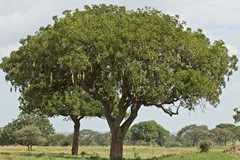
A sausage tree in full leaf during the rainy
season. They are evergreen in areas of high
rainfall. This specimen is growing in
Tarangire National Park
The tree is found on riverbanks, where it may reach 20m, along streams and on floodplains, and also in open woodland.
It is a tree that grows up to 20m tall and has a dense, rounded to spreading crown. The bark is grey and smooth at first, peeling on older trees. It can be as thick as 6 mm on a 15-cm branch. The wood is pale brown or yellowish, undifferentiated and not prone to cracking.
The tree is evergreen where rainfall occurs throughout the year, but deciduous in places where there is a long dry season, such as Ruaha.
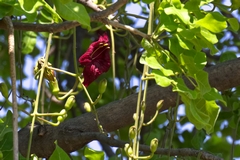
The flowers appear shortly before the rains in
October. Sunbirds are very fond of the nectar
Leaves are compound, with 3 -5 pairs of leaflets up to 20cm long and 6cm broad, plus a single leaf at the tip. They are opposite and elliptic, with a rounded tip and a smooth, wavy, entire margin. Most terminal leaves have serrated ends. The leaves are characteristically thick, roughly hairy on both surfaces, yellowish-green above, paler green below, leathery and rigid. They are broadly tapering to rounded.
The flowers, and later the fruit, hang down from branches on long flexible stems 2-6m long. Flowers are produced in panicles; they are bell-shaped, orange to reddish or purplish green, and about 10 cm wide. Individual flowers do not hang down but are oriented horizontally.
Some birds are attracted to the flowers and the strong stems of each flower make ideal footholds. The flowers stay open at night which is when their scent is most notable. They are adapted to pollination by bats, which visit them for pollen and nectar. They also remain open by day however, and are visited by many insect pollinators, particularly large species such as carpenter bees.
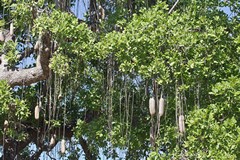
The leaves are characteristically thick, roughly
hairy on both surfaces, yellowish-green
above, paler green below, leathery and rigid.
They are broadly tapering to rounded
The fruit is a hard woody berry from 30–100 cm long and up to 18 cm broad; typically it weighs between 5 and 10 kg, and hangs down on long, rope-like peduncles. The fruit is fibrous and pulpy, and contains numerous seeds. It is eaten by several species of mammals, including baboons, bushpigs, savannah elephants, giraffes, hippopotamuses, monkeys, and porcupines. The seeds are dispersed in their dung. The seeds are also eaten by brown Parrots, and the foliage by elephants and greater kudu.
In Malawi, roasted fruits are used to flavour beer and aid fermentation. The tough wood is used for shelving and fruit boxes, and dugout canoes are made from the tree in Botswana and Zimbabwe. Roots are said to yield a bright yellow dye. Traditional remedies prepared from crushed, dried or fresh fruits are used to deal with ulcers, sores and syphilis - the fruit has antibacterial activity.
In African herbal medicine, the fruit is believed to be a cure for a wide range of ailments, from rheumatism, snakebites, evil spirits, and syphilis.
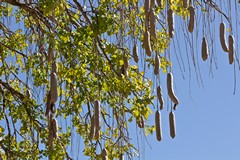
These fruits are still growing at the end of June
An alcoholic beverage similar to beer is also made from it but the fresh fruit is poisonous and strongly purgative and causes blisters on the mouth and skin.
Today, beauty products and skin ointments are prepared from fruit extracts. In time of scarcity, seeds are roasted and eaten.
In Botswana the timber is used for makoros (canoes), yokes and oars. Kigelia is also used in a number of skin care products. There are some steroid chemicals found in the sausage tree that are currently added to commercially available shampoos and facial creams.
The fruits and bark, ground and boiled in water, are also taken orally or used as an enema in treating children's stomach ailments – usually intestinal worms. The Shona people tend to use the bark or root as powder or infusion for application to ulcers, drunk or applied in the treatment of pneumonia, as a gargle for toothache, and the leaves in a compound applied for backache.
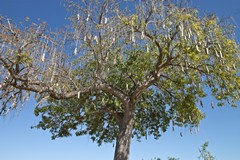
This tree is starting to drop its leaves in
preparation for the long dry season ahead
Researchers conducted tests on an extract of stem bark and two major iridoids against Bacillus subtilis, Escherichia coli, Pseudomonas aeruginosa, Staphylococcus aureus and Candida albicans. Their conclusion was that 'the extract tested had pronounced inhibitory effect against all microorganisms'.
These tests support the traditional use as a natural antibacterial agent. Chemical analyses of the roots, wood and leaves have shown the presence of various medicinally useful compounds within different parts of the plant.
The soothing properties of a cream made from the fruit are effective in treating mosquito bites. Also a piece of sausage tree fruit applied to the area of a Tsetse fly bite is reported to reduce the pain and inflammation. The cream helps to slow down bleeding from cuts to the skin and accelerate healing.
The sausage tree found its use even in music. Native xylophone is made of sausage tree wood.
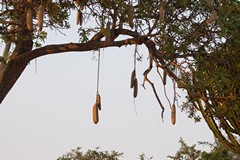
If one of these full sized fruits fell on your
head it could do some serious damage
In some African tribes, the Kigelia is worshipped as a holy tree. Village indabas (important meetings) are held at its base, and relics carved from the wood are revered. Masaai girls carry dolls made from the pods. In the Ndebele tribe, if a family member dies far from home, a Sausage Tree fruit will be buried in place of the body. The tree is also believed to contain powerful medicine to ward away evil-spirits.
There is a widespread local belief that sausage tree fruits, when hung in your hut, will ward-off whirlwinds.